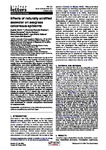Effects of naturally acidified seawater on seagrass calcareous epibionts
| dc.contributor.author | Martin, S | |
| dc.contributor.author | Rodolfo-Metalpa, R | |
| dc.contributor.author | Ransome, E | |
| dc.contributor.author | Rowley, S | |
| dc.contributor.author | Buia, M-C | |
| dc.contributor.author | Gattuso, J-P | |
| dc.contributor.author | Hall-Spencer, J | |
| dc.date.accessioned | 2013-02-20T10:51:29Z | |
| dc.date.available | 2013-02-20T10:51:29Z | |
| dc.date.issued | 2008-12-23 | |
| dc.identifier.issn | 1744-9561 | |
| dc.identifier.issn | 1744-957X | |
| dc.identifier.uri | http://hdl.handle.net/10026.1/1344 | |
| dc.description.abstract |
<jats:p> Surface ocean pH is likely to decrease by up to 0.4 units by 2100 due to the uptake of anthropogenic CO <jats:sub>2</jats:sub> from the atmosphere. Short-term experiments have revealed that this degree of seawater acidification can alter calcification rates in certain planktonic and benthic organisms, although the effects recorded may be shock responses and the long-term ecological effects are unknown. Here, we show the response of calcareous seagrass epibionts to elevated CO <jats:sub>2</jats:sub> partial pressure in aquaria and at a volcanic vent area where seagrass habitat has been exposed to high CO <jats:sub>2</jats:sub> levels for decades. Coralline algae were the dominant contributors to calcium carbonate mass on seagrass blades at normal pH but were absent from the system at mean pH 7.7 and were dissolved in aquaria enriched with CO <jats:sub>2</jats:sub> . In the field, bryozoans were the only calcifiers present on seagrass blades at mean pH 7.7 where the total mass of epiphytic calcium carbonate was 90 per cent lower than that at pH 8.2. These findings suggest that ocean acidification may have dramatic effects on the diversity of seagrass habitats and lead to a shift in the biogeochemical cycling of both carbon and carbonate in coastal ecosystems dominated by seagrass beds. </jats:p> | |
| dc.format.extent | 689-692 | |
| dc.format.medium | ||
| dc.language | en | |
| dc.language.iso | eng | |
| dc.publisher | The Royal Society | |
| dc.subject | acidification | |
| dc.subject | CO2 | |
| dc.subject | carbonate production | |
| dc.subject | calcareous epibionts | |
| dc.subject | coralline algae | |
| dc.title | Effects of naturally acidified seawater on seagrass calcareous epibionts | |
| dc.type | journal-article | |
| dc.type | Article | |
| plymouth.author-url | https://www.ncbi.nlm.nih.gov/pubmed/18782731 | |
| plymouth.issue | 6 | |
| plymouth.volume | 4 | |
| plymouth.publication-status | Published | |
| plymouth.journal | Biology Letters | |
| dc.identifier.doi | 10.1098/rsbl.2008.0412 | |
| plymouth.organisational-group | /Plymouth | |
| plymouth.organisational-group | /Plymouth/Faculty of Science and Engineering | |
| plymouth.organisational-group | /Plymouth/Faculty of Science and Engineering/School of Biological and Marine Sciences | |
| plymouth.organisational-group | /Plymouth/PRIMaRE Publications | |
| plymouth.organisational-group | /Plymouth/REF 2021 Researchers by UoA | |
| plymouth.organisational-group | /Plymouth/REF 2021 Researchers by UoA/UoA07 Earth Systems and Environmental Sciences | |
| plymouth.organisational-group | /Plymouth/Research Groups | |
| plymouth.organisational-group | /Plymouth/Research Groups/Marine Institute | |
| plymouth.organisational-group | /Plymouth/Users by role | |
| plymouth.organisational-group | /Plymouth/Users by role/Academics | |
| dc.publisher.place | England | |
| dc.identifier.eissn | 1744-957X | |
| dc.rights.embargoperiod | Not known | |
| rioxxterms.versionofrecord | 10.1098/rsbl.2008.0412 | |
| rioxxterms.licenseref.uri | http://www.rioxx.net/licenses/all-rights-reserved | |
| rioxxterms.type | Journal Article/Review |


